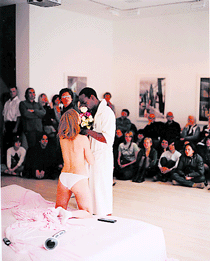Suggestions of a soul behind the curtain of American affluence
“In Search of a Purple Heart” a site-specific performance, written and directed by photographer Noritoshi Hirakawa, was presented twice on Sunday, February 27. The performances took place at Salon 94, a satellite of Artemis Greenberg Van Doren Gallery on East 94th Street just off Fifth Avenue.
Jeanne Greenberg Rohatyn provided brunch and later gathered the 40 or so attendees into the exhibition space for the event. Curved white walls exhibited the artist’s photographs of the University of Toronto’s Graduate House, a project recently completed by Thom Mayne of the Morphosis architectural firm. Hirakawa’s documentation of the architecture includes groups of figures in sexually ambiguous poses, such as a woman draped over a banister with her skirt up and a man in a woman’s dress walking as if asleep.
Across the room, a semi-circle of floor-to-ceiling windows looked out onto a garden. A large bed covered in apricot-colored silks rested in the center of the room. The audience stood along the walls, looking toward the bed as light gray curtains were pulled across the windows. A musician sat to the side and delicately tapped his fingers across the surface of a goatskin-framed drum.
The performance began as a Latino man approached the center of the room with a bouquet of roses. Soon, a blond woman settled onto the bed and looked at video images of herself on a monitor and spoke into a cell phone. The performers next began repeating snatches of sentences, redacted from interviews with American Vietnam War veterans, as they moved among choreographed positions. The woman partially disrobed and mimed masturbation, writhing on the bed.
An African-American man in a white bathrobe entered the space through the glass garden door. The woman approached him. They embraced in stylized movements. After more bits of appropriated dialogue—such as “Do you know what you are asking? Do you have any idea of the nature of your question?”—the performers left the space in spider-like movement, crawling hand and foot, one over the other.
The performance lasted 20 minutes. The intense compilation of atmospheres that Hirakawa assembled within the stylish environment of a Museum Mile townhouse gallery began to sort themselves out in the audience’s memory after the performance. Hirakawa is intent on infecting the seductive surfaces that dominate our culture, as typified by the gallery, with the rot of our culture’s collective guilt. The affective allure of cosmetic and spa environments, high-end pornographic films and fashion imagery dominate Hirakawa’s work, as symbols for America’s affluent life. His appropriation of memories from veterans hint at the general malaise he believes to be hidden in our culture.
The question that Hirakawa cannot answer—and is no clearer after this performance—is, “Does America really have a conscience?” The value of Hirakawa’s work lies in our consideration of this question. The glossy reality of current American life may have left such consideration far behind.
gaycitynews.com



































